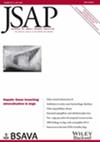Trends in urolith composition and factors associated with different urolith types in dogs from the Republic of Ireland and Northern Ireland between 2010 and 2020
Abstract
Objectives
The purpose of this study was to determine changes in urolith trends and factors associated with different urolith types in dogs from the Republic of Ireland and Northern Ireland between 2010 and 2020.
Materials and Methods
A laboratory database was searched for canine urolith submissions between 2010 and 2020. Trends in urolith composition between 2014 and 2020, and associations between patient characteristics with each urolith type were evaluated.
Results
A total of 1162 submissions were included. Struvite (39.0%), calcium oxalate (27.8%) and compound (10.2%) were the most prevalent uroliths. Calcium oxalate urolith (CaOx) incidence significantly increased from 27.8% to 31.2% and that of struvite significantly decreased from 41.7% to 33.0% between 2014 and 2020. Struvite uroliths were overrepresented among females compared to males (odds ratio 8.7, 95% confidence interval 6.6 to 11.5). Males (odds ratio 9.6, 95% confidence interval 6.9 to 13.3) and dogs >7 years of age (odds ratio 4.1, 95%, confidence interval 3.0 to 5.4) were more likely to have CaOx while males (odds ratio 9.6, 95% confidence interval 5.3 to 17.8) and dogs ≤7 year of age, purine uroliths (odds ratio 3.0, 95% confidence interval 1.8 to 5.0). Incidence was higher in bichon frise (odds ratio 1.7, 95% confidence interval 1.3 to 2.4) and Yorkshire terrier (odds ratio 2.8, 95% confidence interval 1.9 to 4.1) for CaOx and higher in shih-tzu for compound uroliths (odds ratio 1.7, 95% confidence interval 1.1 to 2.7) compared to the remaining reported breeds.
Clinical Significance
Factors associated with different uroliths were similar to the ones previously reported. Proportion of CaOx submissions increased and that of struvite decreased over the study period which was in agreement with the changes identified in other European countries.

 求助内容:
求助内容: 应助结果提醒方式:
应助结果提醒方式:


